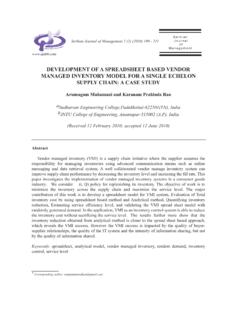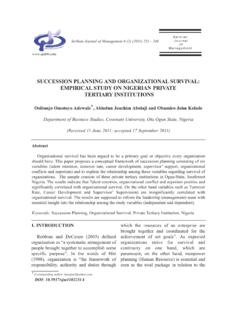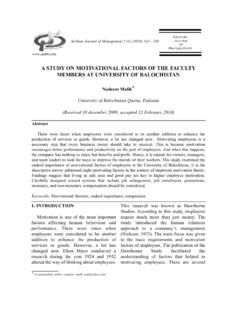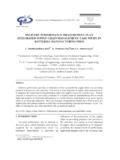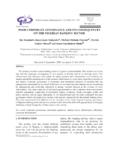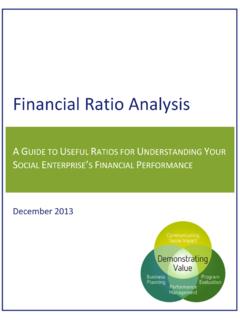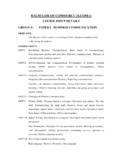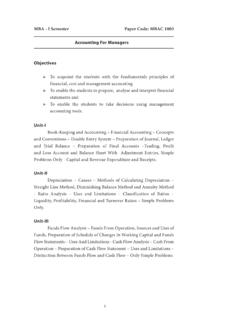Transcription of A STUDY OF USING FINANCIAL AND NON …
1 1. INTRODUCTIONN owadays, chief executive officers ofmost organization and profit seeking as wellnon for profit seeking companies, spendmuch time, energy and FINANCIAL sources inorder to editing the basic tactics of theirunits; but most of them talk about non-A STUDY OF USING FINANCIAL AND NON- FINANCIAL CRITERIAIN EVALUATING PERFORMANCE: SOME EVIDENCE OF IRANM ahdi Salehia*and Behzad GhorbanibaAccounting and Management Department, Guilan University, 1, Nagilo Alley, Hidaj City, Zanjan Province, IranbIslamic Azad University, Khodabandeh Branch, Iran(Received 17 May 2010; accepted 13 January 2011)AbstractThe success of any organization is reflected upon by its performance which is in turn highlydependent upon its strategies. In this era of cut-throat competition, what an organization requires isnot just framing the right strategies, but also managing the same.
2 The impact of the right strategieswill automatically be reflected in the results. This research includes analyzing balanced scorecard(BSC) is inclusively. BSC pays attention to institutions traditional criteria evaluation financialand non- FINANCIAL criteria that are mostly guidance and controlling criteria. Therefore, the mainquestions of this research include: How much FINANCIAL and non- FINANCIAL criteria are used to evaluatethe efficiency? Do the efficiency evaluators who know well about balanced scorecard pay moreattention to non- FINANCIAL criteria? The results of T-test, independence sample, multi variable singlevariance analysis test and Tokay test, the following show the efficiency evaluators are mostly interested in USING FINANCIAL criteria rather than non- FINANCIAL once; and second USING non- FINANCIAL criteria, there was significant difference betweenthose evaluators who were familiar with BSC and the : Balanced scorecard, balanced scorecard views, efficiency evaluation, FINANCIAL criteria,and non- FINANCIAL criteria.
3 *Corresponding author: Journalof ManagementSerbian Journal of Management 6 (1) (2011) 97 - 108 of their strategies. The views thatthese CEOs have for their units, are clear forthemselves but understanding of theire staffsfrom these views is not enough and they donot follow these strategies well in order tomeet the goals. Moreover, any organizationhas to understand that it needs to giveimpetus not only towards the financialresults but also towards satisfaction of thecustomers, development of state-of-the-arttechnologies and creation of an environmentof learning and growth. The BalancedScorecard is such an innovative tool whichhas considered not just the FINANCIAL indicesbut also the non- FINANCIAL indicators asequally critical in determining organizationalperformance. The advantage of this methodis that it can allow the managers to know thevacuum of work as good as it can betransferring this strategy to the totalcompany , top managers always look for asolution to be assumed from the efficiency oftheir strategies and in this end, efficiencyevaluation methods are selected as tools forcontrolling the way how these strategies arebeing used.
4 Although, the features ofeconomic age based on knowledge andinformation, underline the efficiency oftraditional efficiency evaluation methodsthat seem worth full organizations in theeconomic age. In these situations BSC firstwas developed as a modern method ofefficiency this research, welook for how much we should use financialand non- FINANCIAL criteria for evaluating theefficiency. BSC emphasizes on the point thatin evaluating the efficiency. Not onlyfinancial criteria should be considered, butalso other criteria should be noticed in longterm and from all aspects. The importance ofevaluating FINANCIAL views is that they candetermine the results of other views activities(non- FINANCIAL criteria). Though, theseexplanations don t mean to lessen theimportance of FINANCIAL criteria, becauseimproving these criteria shows the success ofthe unit in gaining experience as the mostpivotal goal, especially in non- stateorganizations.
5 So, it should be tried toevaluate these BSC: THE CONCEPTIn 1990 Robert Kaplan and Davis Nortoncarried out a yearlong research project with12 organizations at the leading edge ofperformance measurement. They came to theconclusion that traditional performancemeasures, having a FINANCIAL bias and beingcentered on issues of control, ignored the keyissue of linking operational performance tostrategic objectives and communicatingthese objectives and performance results toall levels of the organization (Corrigan,1995; Stefanovic et al., 2010). Realizing thatno single measure can provide a clearperformance target or focus attention on allthe critical areas of business, they proposedthe concept of a Balanced Scorecard as amore sophisticated approach for meetingthese and Norton are of the opinion thatthe BSC has its greatest impact whendeployed to drive organizational change.
6 In arapidly changing environment, innovativefirms are increasingly USING the BSC toidentify and communicate key factors thatdrive future values (Kaplan & Norton, 1996)giving better indicators of where theorganization is is accomplished by translating visionand strategy into objectives and measures,providing a framework to communicate thisvision and strategy to employees, / SJM 6 (1) (2011) 97 - 108thereby channeling the energies, the abilities,and the specific knowledge of peoplethroughout the organization towardsachieving long-term goals. By developing aset of measures that gives managers a fastand comprehensive view of the organization(Kaplan & Norton, 1992), the BSC methodstrives to focus the whole organization onwhat must be done to create breakthroughperformance. The Scorecard takes thecompany s vision, translates each keystatement into measurable steps and thenpresents information so that the criticalsuccess factors can be evaluated andcompared (Campbell, 1997; Umukoro et al.)
7 ,2009).By measuring organizational performanceacross four balanced perspectives, the BSCcomplements traditional FINANCIAL indicatorswith measures for customers, internalprocesses, and innovation and improvementactivities (Kaplan & Norton, 1996) whichin turn must all be linked to the organizationsstrategic vision. This innovative tool isunique in two ways compared to thetraditional performance measurement are:(i) It considers the FINANCIAL indices aswell the non- FINANCIAL ones in determiningthe corporate performance level and(ii) It is not just a performancemeasurement tool but is also a performancemanagement the words of the proponents of this toolthe BSC retains traditional measures. But, FINANCIAL measures tell the story of pastevents, an adequate story for industrial agecompanies for which investment in long-term capabilities and customer relationshipswere not critical for success.
8 These financialmeasures are inadequate however, forguiding and evaluating the journey thatinformation age companies must make tocreate future value through investment incustomers, suppliers, employees, processes,technologies and innovation. These wordsgive the idea behind the development of thisframework. Today s businesses require abetter understanding of their customers (bothexisting and potential) and their needs, betterstreamlined processes and highly skilledpeople for ensuring future survival andsustainable growth. This shows that the focusof action has rightly considered the non- FINANCIAL aspects apart from the financialindices. This tool is the end result ofsustained efforts to find an ideal tool tomeasure performance and provide a link tostrategy and action. The decisions about thefuture actions form the key to success of anyenterprise in this fast-changing aim of the BSC is to direct, helpmanage and change in support of the longer-term strategy in order to manageperformance.
9 The scorecard reflects what thecompany and the strategies are all about. Itacts as a catalyst for bringing in the change element within the organization. This tool isa comprehensive framework which considersthe following perspectives and tries to getanswers to the following questions:1. FINANCIAL Perspective - How do welook at shareholders?2. Customer Perspective - How should weappear to our customers?3. Internal Business Processes Perspective- What must we excel at?4. Learning and Growth Perspective - Canwe continue to improve and create value?While, it is proved now that the number ofthese views is different based on contain andscope of attention related to efficiency the following, introduced views byKaplan and Norton will be given in / SJM 6 (1) (2011) 97 - Customer viewFor choosing goals and those criteriarelated to the customer s view, organizationshould answer two pivotal questions: First,who are our intended customers?
10 Andsecond, what are our suggested opinions forthem? Often, organizations choose theircustomer view among the following ones. Operational superiority- thoseorganizations that choose operationalsuperiority rather than finished pricereduction, focus on improving their productoperation and the ease of USING product andservices. Lead in product-Those organizationsthat choose lead in product strategy, focus oncontinuous innovation and providing betterproduct or services in the market place. Customer-based strategy-In thisstrategy, meeting the needs and customerssatisfactions and providing a solution fortheir problems and maintaining win-win longterm relation with customers is basic goals Business internal processes viewIn the view of internal processes, theorganizations should determine the strategiesthat can make value for customers and shareholders by being superior in them.
